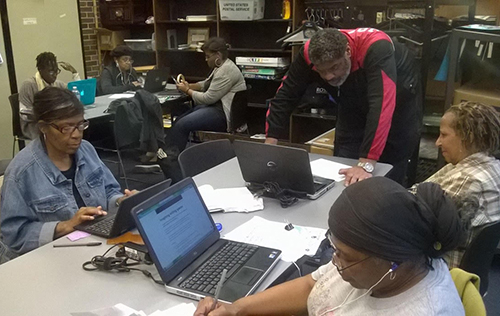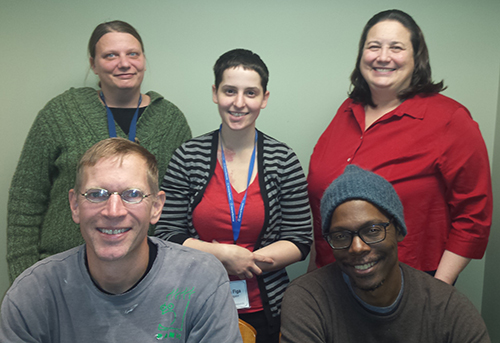Host Learning Circles for greater online learning success
 Most libraries offer programs that bring patrons together to learn, and many offer access to online learning programs, but what about bringing patrons together as a community around online learning?
Most libraries offer programs that bring patrons together to learn, and many offer access to online learning programs, but what about bringing patrons together as a community around online learning?
That's the thinking of Peer 2 Peer University (P2PU) and the Chicago Public Library (CPL), who over the past year created the concept of Learning Circles and have explored the possibilities, built the tools and tested their theories at more than a dozen branches of CPL.
P2PU was founded in 2009 and works to build online courses and tools to create more collaborative and creative learning experiences. Originally focused on creating online courses, they realized they couldn't compete with the huge numbers of MOOCs (massive open online courses) being generated, and switched their focus to support organizations that want to create community around online learning. CPL has 80 locations, a service area of about 2.7 million people and approximately 11 million visitors yearly.
Online learning has a lot going for it in theory: it's convenient to schedules, much is available for free, and is available wherever you have access to a computer and the internet. That's, however, assuming quite a bit, especially considering that 26% of white Americans, 36% of black Americans and 47% of Hispanic/Latino Americans don't have broadband at home. This also assumes a level of comfortability and skill using online resources, which may not always be fair to assume.
"It was frustrating to P2PU to see how inequitable online learning was despite opening information to all," says Grif Peterson, of P2PU. "Well over 50% of online learners already have college degrees, for example. P2PU prides itself on trying to make online learning more equitable."
P2PU and CPL found that augmenting the pros of online learning with the unique advantages that public libraries offer can mitigate some of the cons often experienced. Public libraries provide free online access, as well as access to the learning platforms themselves. Libraries can also convene groups in small and large numbers (mitigating loneliness often cited with online learning) in a non-intimidating space, and can reach patrons who might not otherwise know that online learning is an option.
"Online resources can be really beneficial for adult learners, you just have to go a little above and beyond putting it online," says Peterson.
The partnership between P2PU and CPL began with a connection through a P2PU board member, and really gained traction when the Learning Circles project won a 2015 Knight News Challenge on Libraries grant in January 2015.
P2PU started by working closing with CPL staff and patrons exploring what Learning Circles could help libraries provide beyond simply making the courses available. P2PU did a deep dive into what might be barriers to both library staff and patrons and worked to formulate Learning Circles in a way that would meet the potential barriers to success.
The basics of the Learning Circle model at CPL were five- to eight-week courses offered on a range of subjects (from finances to fiction writing) via platforms such as Coursera and Khan Academy. The patrons met for 90 minutes each week at the library for Learning Circles, and, according to Peterson, "the librarian is the facilitator helping draw out knowledge within the circle of learners." These lightly facilitated study groups allowed patrons to learn at different paces, and the format drew out questions and encouraged patrons to be inquisitive and engage with fellow learners.
 Over two rounds of courses at CPL that P2PU guided, "results were good, there was 45% retention over the weeks, which is much higher than online alone," says Peterson. According to CPL, 90% are interested in taking another class, 70% achieved the goals they set and 70% say they were supported by their peers.
Over two rounds of courses at CPL that P2PU guided, "results were good, there was 45% retention over the weeks, which is much higher than online alone," says Peterson. According to CPL, 90% are interested in taking another class, 70% achieved the goals they set and 70% say they were supported by their peers.
For the CPL libraries, never had so many different branches run the same adult program at the same time. For the first two rounds, 11 branches hosted 18 Learning Circles for patrons of diverse gender, age, ethnicity and background, and many were completely new to online courses. Read more about CPL's experience with the first two rounds of Learning Circles.
This month the third round of Learning Circles started at 15 CPL branches with minimal additional assistance from P2PU.
There are certainly aspects of offering Learning Circles that are important to understand and anticipate. Peterson says, "It's a little utopian to think that just any group can sit together and learn." First steps include orienting patrons about what to expect from the Learning Circle and helping them set reasonable goals for themselves. Learners also fill out a short survey at the beginning of the Learning Circle to help people feel welcome, but also to serve as a baseline for measuring the digital skills of participants, providing a way to group patrons with similar levels and interests.
If the concept of Learning Circles intrigues you, make sure to watch the archived webinar Introducing Learning Circles: Online Learning, Offline. The event features more details of the program and recent highlights by presenters Peterson of P2PU and Kate Lapinski of Chicago Public Library.
And make sure to check out the open source toolkit that is freely available on the P2PU website.
Photos:
Top: The Start Writing Fiction Learning Circle in action at the CPL Whitney Young Branch.
Bottom: Members of the Resume Writing and Interview Skills Learning Circle at the CPL Lincoln Belmont Branch.
